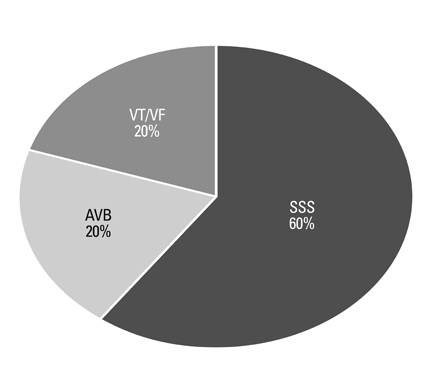Yonsei Med J.
2013 May;54(3):590-595. 10.3349/ymj.2013.54.3.590.
Usefulness of an Implantable Loop Recorder in Patients with Syncope of an Unknown Cause
- Affiliations
-
- 1Department of Medicine, Samsung Changwon Hospital, Sungkyunkwan University School of Medicine, Changwon, Korea.
- 2Department of Medicine, Cardiac and Vascular Center, Samsung Medical Center, Sungkyunkwan University School of Medicine, Seoul, Korea. juneskim@skku.edu
- 3Department of Pediatrics, Cardiac and Vascular Center, Samsung Medical Center, Sungkyunkwan University School of Medicine, Seoul, Korea.
- KMID: 1727869
- DOI: http://doi.org/10.3349/ymj.2013.54.3.590
Abstract
- PURPOSE
The mechanisms underlying syncope remain unknown in about 20% of patients with recurrent syncope. The implantable loop recorder (ILR) has been shown to be a useful diagnostic tool in patients with unexplained syncope even after negative initial evaluations. Nevertheless, ILR has rarely been used in clinical practice.
MATERIALS AND METHODS
This study included 18 consecutive patients who had an ILR implanted at our center because of recurrent unexplained syncope after extensive diagnostic tests between February 2006 and June 2011.
RESULTS
Diagnosis was confirmed in 10 (55.6%) of the 18 enrolled patients (13 males, 61+/-15 years). The confirmed diagnoses included sick sinus syndrome (n=6, 60%), advanced atrioventricular block (n=2, 20%) and ventricular tachyarrhythmia (n=2, 20%). The mean follow-up durations of the total study subjects and the diagnosed patients were 11.3+/-10.6 months and 5.6+/-9.2 months, respectively. Of the 10 diagnosed patients, 8 (80%) were diagnosed within 6 months of loop recorder implantation.
CONCLUSION
ILR may be a valuable and effective diagnostic tool for patients with unexplained syncope.
Keyword
MeSH Terms
Figure
Reference
-
1. Task Force for the Diagnosis and Management of Syncope. European Society of Cardiology (ESC). European Heart Rhythm Association (EHRA). Heart Failure Association (HFA). Heart Rhythm Society (HRS). Moya A, et al. Guidelines for the diagnosis and management of syncope (version 2009). Eur Heart J. 2009. 30:2631–2671.2. Brignole M, Ungar A, Bartoletti A, Ponassi I, Lagi A, Mussi C, et al. Standardized-care pathway vs. usual management of syncope patients presenting as emergencies at general hospitals. Europace. 2006. 8:644–650.
Article3. Suzuki T, Matsunaga N, Kohsaka S. Diagnostic patterns in the evaluation of patients hospitalized with syncope. Pacing Clin Electrophysiol. 2006. 29:1240–1244.
Article4. Edvardsson N, Frykman V, van Mechelen R, Mitro P, Mohii-Oskarsson A, Pasquié JL, et al. Use of an implantable loop recorder to increase the diagnostic yield in unexplained syncope: results from the PICTURE registry. Europace. 2011. 13:262–269.
Article5. Lombardi F, Calosso E, Mascioli G, Marangoni E, Donato A, Rossi S, et al. Utility of implantable loop recorder (Reveal Plus) in the diagnosis of unexplained syncope. Europace. 2005. 7:19–24.
Article6. Shin DH, Kim JS, Park JW, Yim HR, Kim JH, Lee SM, et al. The use of an implantable loop recorder in patients with syncope of unknown origin. Korean Circ J. 2008. 38:205–211.
Article7. Kang GH, Oh JH, Kim JS, On YK, Song HG, Jo IJ, et al. Diagnostic patterns in the evaluation of patients presenting with syncope at the emergency or outpatient department. Yonsei Med J. 2012. 53:517–523.
Article8. Pires LA, Ganji JR, Jarandila R, Steele R. Diagnostic patterns and temporal trends in the evaluation of adult patients hospitalized with syncope. Arch Intern Med. 2001. 161:1889–1895.
Article9. Boersma L, Mont L, Sionis A, García E, Brugada J. Value of the implantable loop recorder for the management of patients with unexplained syncope. Europace. 2004. 6:70–76.
Article10. Vitale E, Ungar A, Maggi R, Francese M, Lunati M, Colaceci R, et al. Discrepancy between clinical practice and standardized indications for an implantable loop recorder in patients with unexplained syncope. Europace. 2010. 12:1475–1479.
Article11. Brignole M, Menozzi C, Moya A, Garcia-Civera R, Mont L, Alvarez M, et al. Mechanism of syncope in patients with bundle branch block and negative electrophysiological test. Circulation. 2001. 104:2045–2050.
Article12. Furukawa T, Maggi R, Bertolone C, Fontana D, Brignole M. Additional diagnostic value of very prolonged observation by implantable loop recorder in patients with unexplained syncope. J Cardiovasc Electrophysiol. 2012. 23:67–71.
Article13. Krahn AD, Klein GJ, Yee R, Hoch JS, Skanes AC. Cost implications of testing strategy in patients with syncope: randomized assessment of syncope trial. J Am Coll Cardiol. 2003. 42:495–501.
Article14. Giada F, Gulizia M, Francese M, Croci F, Santangelo L, Santomauro M, et al. Recurrent unexplained palpitations (RUP) study comparison of implantable loop recorder versus conventional diagnostic strategy. J Am Coll Cardiol. 2007. 49:1951–1956.15. Arzbaecher R, Hampton DR, Burke MC, Garrett MC. Subcutaneous electrocardiogram monitors and their field of view. J Electrocardiol. 2010. 43:601–605.
Article
- Full Text Links
- Actions
-
Cited
- CITED
-
- Close
- Share
- Similar articles
-
- Diagnostic usefulness of implantable loop recorder in patients with unexplained syncope or palpitation
- Clinical Approach and Diagnosis of Syncope
- The Use of an Implantable Loop Recorder in Patients With Syncope of Unknown Origin
- Usefulness of an Implantable Loop Recorder in Diagnosing Unexplained Syncope and Predictors for Pacemaker Implantation
- Impact of an expanded reimbursement policy on utilization of implantable loop recorders in patients with cryptogenic stroke in Korea



